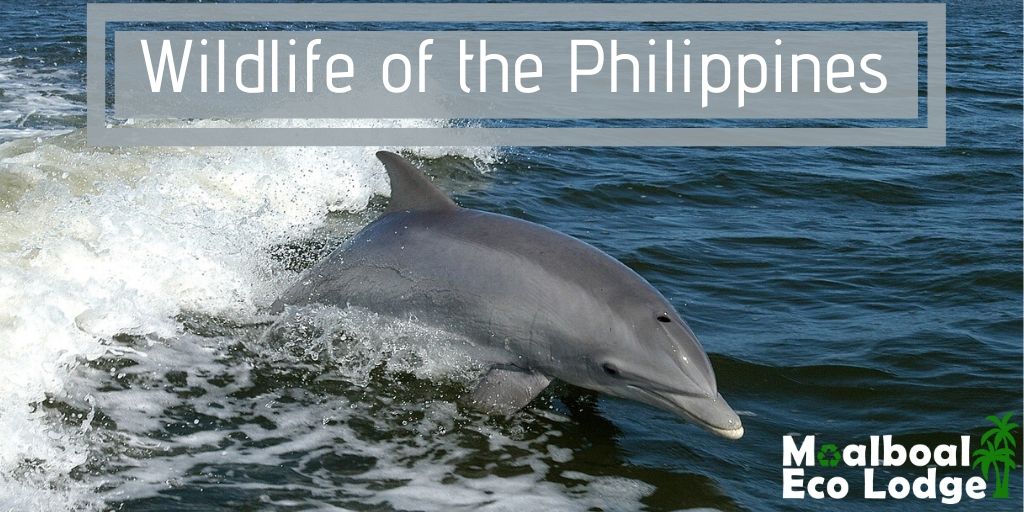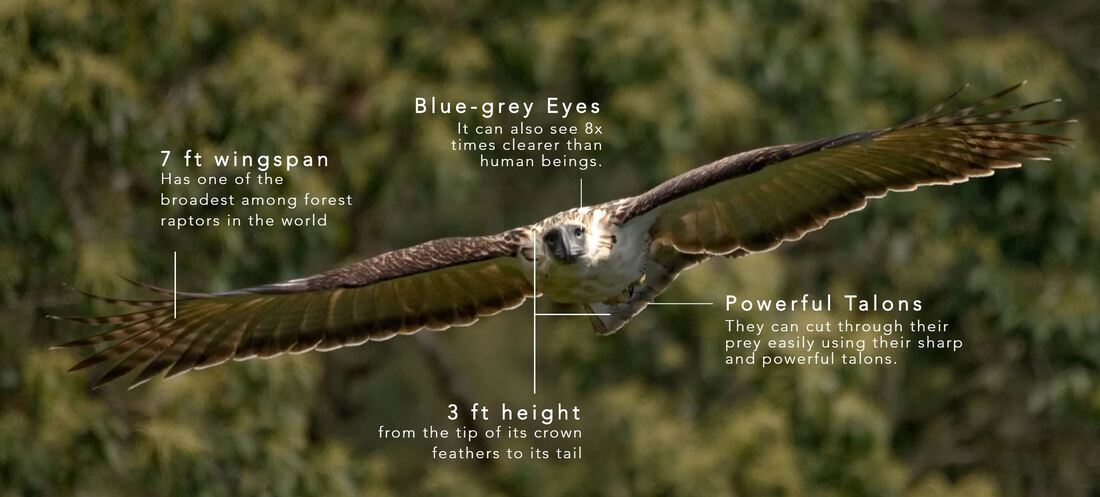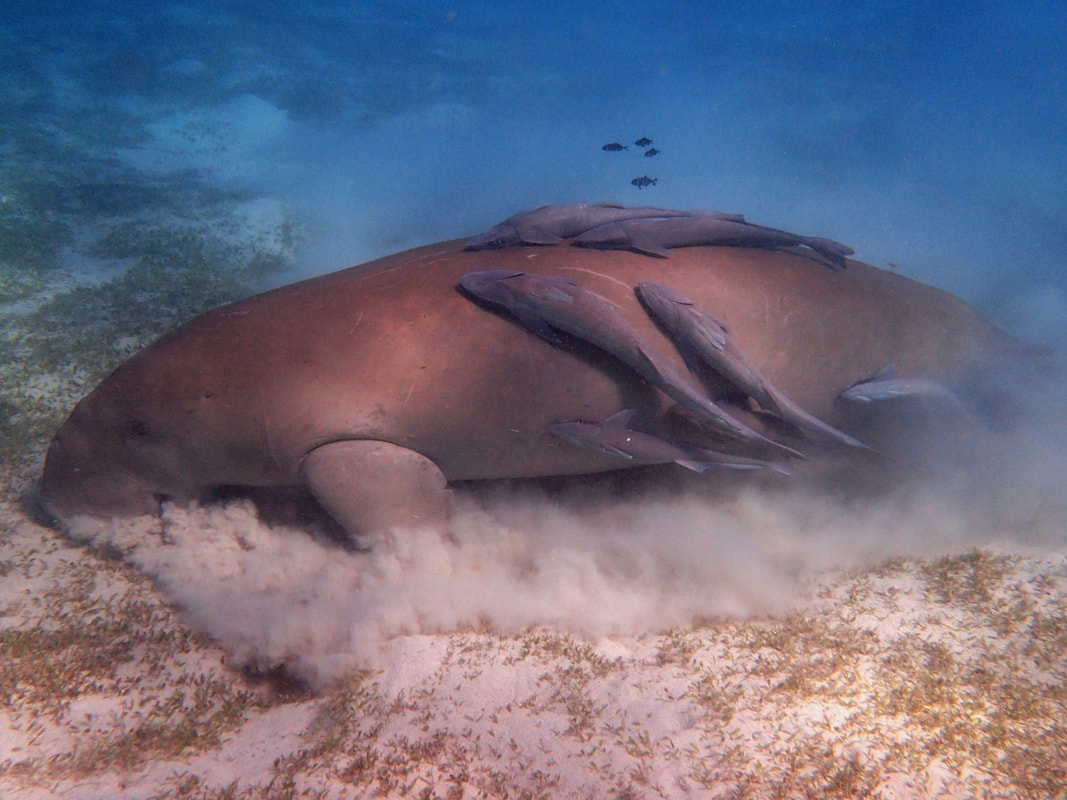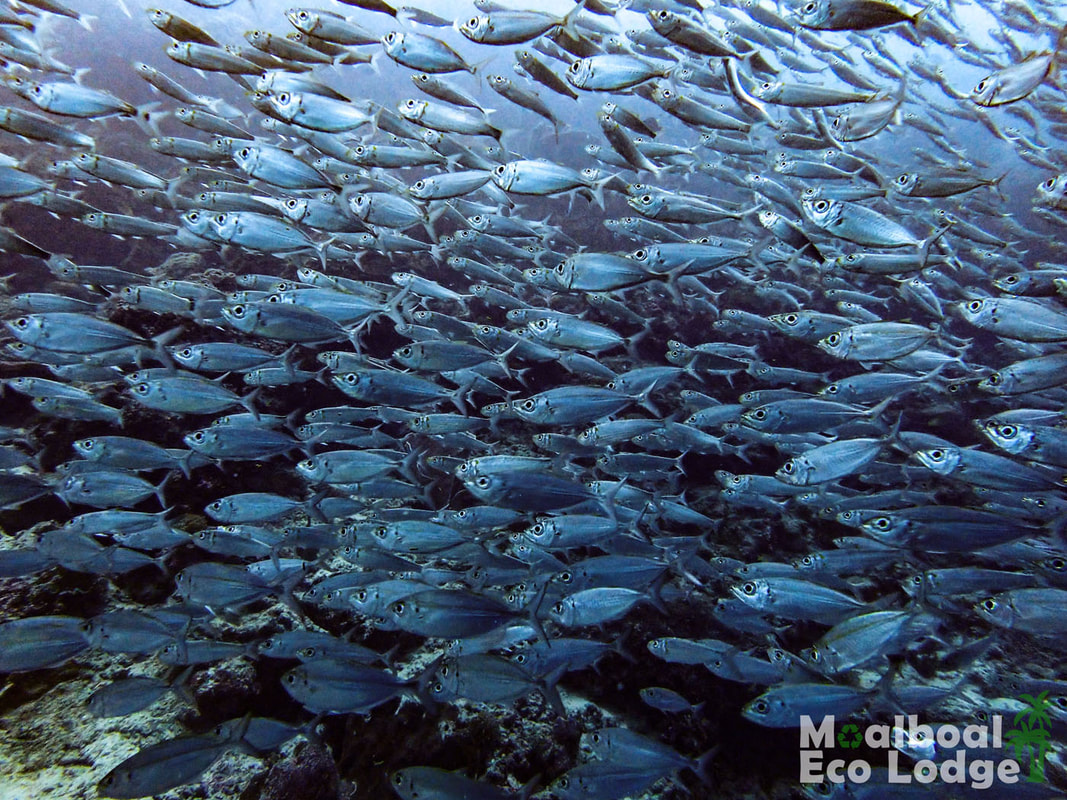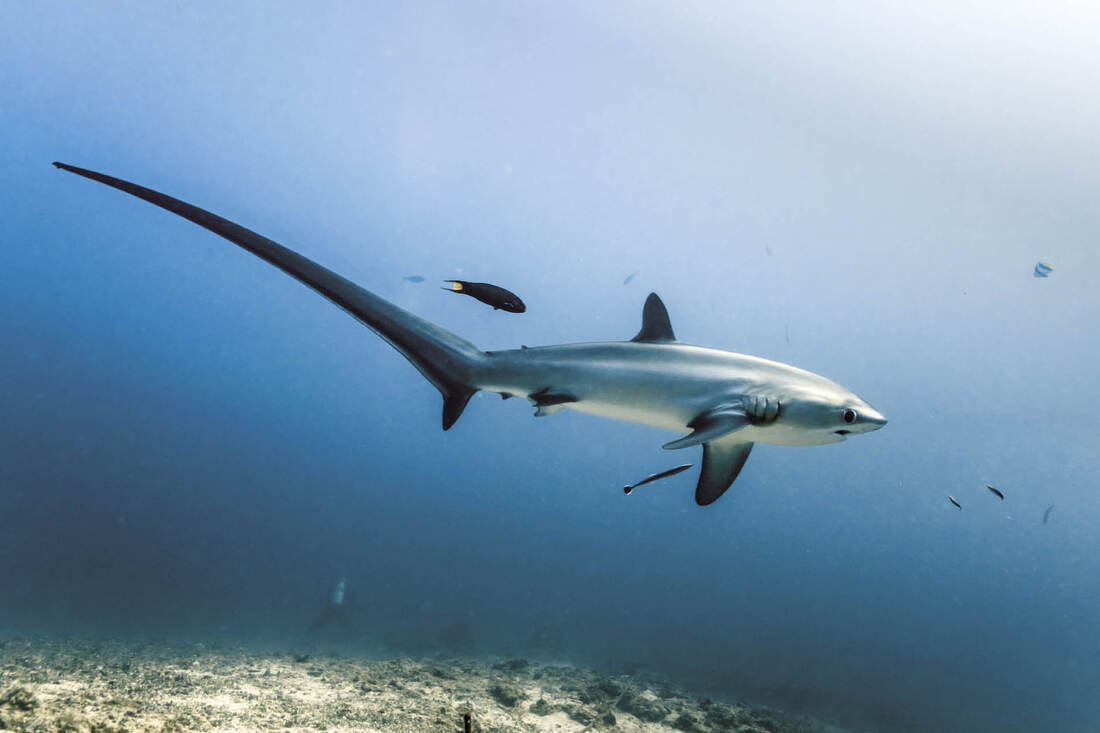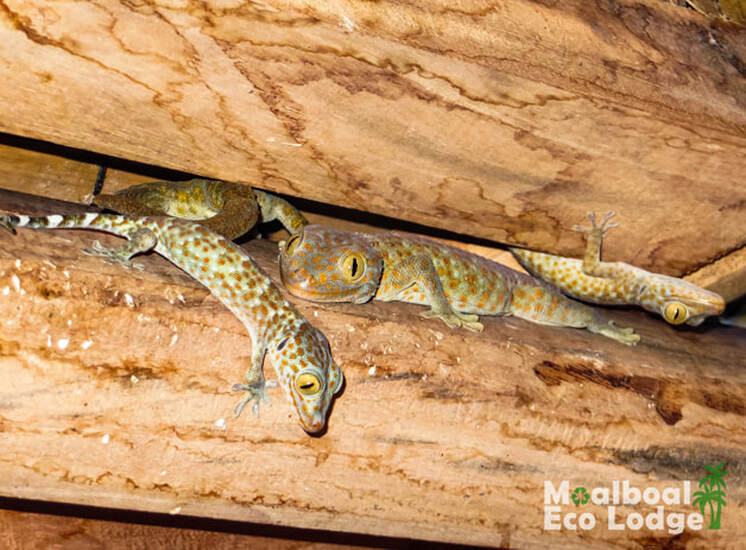|
The Philippines is located in the coral triangle, the most bio-diverse region in the world. When asked “what wildlife can I see in the Philippines”, with over 52,177 species of wildlife, the answer is “a lot”.
For animal lovers, there is plenty to be seen above and below the water. The most famous wildlife found in the Philippines is the whale shark, but there is also the Philippine Tarsier, the smallest primate in the world, and the Philippine Eagle, the largest eagle in the world, and endemic to the Philippines. Do you know where to find the world’s largest flower, the Rafflesia, in the Philippines? At Moalboal Eco Lodge, we are huge animal lovers, and are surrounded by nature day and night. Regardless of whether wildlife is big or small, bird, insect, or fish, we are passionate them all. In this article, we share 10 different wildlife which we feel are the most impressive for various reasons. Some of the wildlife featured are only found here in the Philippines, some are iconic, some are weird, and some are just beautiful. So for visiting nature lovers this is wildlife of the Philippines.
1. Philippine Eagle – the Largest Eagle in the World
We have to start with the National Bird of the Philippines – the Philippine Eagle. The Philippine Eagle is endemic to the Philippines, and was first discovered in 1896 by British naturalist and explorer John Whitehead, in Bonga, Samar. It has no known close relatives or sub-species, making it very unique, and it was declared the Philippines National Bird in 1995. Until 1978 it was known as the Monkey Eating Eagle, then it was discovered they eat more than just macaques, so thankfully it was renamed. A powerful raptor, it’s the world’s largest eagle in terms of its length and height, the second largest eagle for its weight, and has incredible eye sight eight times better than humans. Despite their size, they are fast and nimble in the air making them effective hunters catching bats, civets, flying squirrels, birds including other birds of prey, snakes and lizards, and sometimes macaques (it is a Monkey Eating Eagle after all!)
Due to deforestation and poaching, in 1994 the Philippine Eagle was classified as “critically endangered”, and is now one of the rarest birds in the world. It’s estimated there are only 400 pairs left in the wild, but this number declines every year.
The eagle is so important to the Philippines, that whole forests have been protected with the hope of conserving this iconic bird. In 2001, the Government introduced the Philippine Wildlife Conservation Act to help protect it from poaching. It’s now illegal to kill or capture a Philippine Eagle punishable with up to 12 years in prison or P1 million fine. The Philippine Eagle Foundation in Davao City, Mindanao is the only place you can guarantee a sighting. This organisation is dedicated to protecting and conserving the Eagle and its forest habitat. For over a decade they have been successful in captive breeding, and have 36 eagles at the Centre, 19 of which were bred in captivity. This beautiful bird has a bushy crest, white/brown feather pattern, it’s beak and eyes are grey-blue and it has neon yellow feet. It can be found in Samar, East Luzon, and flying freeing in the mountain ranges of Leyte, but these sightings are extremely rare. 5 Fast Facts
2. Brahminy Kite
I have included the Brahminy Kite because we have spotted this beautiful bird of prey hunting around Moalboal Eco Lodge. In the Philippines there are 26 species of hawks, eagles, and kites, and 724 different bird species in total. When inland, they hunt by day soaring high in the air looking their prey of bats, rodents, frogs, small snakes and insects. The best time to see one is at breakfast, although you have to be a keen bird watcher to catch one gliding silently through the bamboo and palm trees. Easily distinguishable from other birds of prey, they have a chestnut (reddish-brown) body plumage, white head and breast. In other parts of the world they are referred to as the Singapore Bald Eagle, but in Australia they are known as the red-backed sea-eagle. Usually they are found scavenging along the coast on dead fish and crabs, but have been known to steal food from other birds. 5 Fast Facts
3. Dugong Sea Cow – Mermaids of the Sea
In North Busuanga, Coron, Palawan you have the opportunity of watching the endangered Dugong all year round. Dugongs are marine mammals and often referred to as sea cows because of their love of eating seagrass, of which they consume up to 25kg per day. They breath using their lungs so need to surface the water every 5-10 minutes to breath air. Dugongs once grazed in their thousands, but these days they can only survive in specially designated areas where they are protected from boat propellers, fishing nets which entangle them, and where food is in abundance.
If you wanted to take a day trip to try and see these cuddly creatures, Dugong Dive Center are environmentalists & members of the Philippines Coast Guard Auxiliary. Sightings are not guaranteed because the Dugong is a wild animal, and this is an ethical activity with no feeding or touching.
At first you search for the Dugong and if found, you will observe from the boat to ensure they are comfortable. Dugong’s are intelligent mammals with long memories, and although they are friendly, they are shy and can be easily frightened. If the Dugong is happy and continues to eat seagrass in your company, then you have the opportunity of snorkelling, and if really lucky you may be able to scuba dive. A distance of at least two metres needs to be maintained to ensure the Dugong doesn’t become stressed. 5 Fast Facts
4. Whale Shark – The Biggest Fish in the World
Whale Sharks are gentle giants of the ocean, and are completely harmless to humans. Despite being the size of a whale, they are the largest member of the shark family (hence its name). They are filter feeders eating mainly plankton, and unlike sharks who swim using their tail, whale sharks swim by moving their bodies side to side. They are featured on the back of the 100 peso bank note. Protected from shark finning under Philippine Law since 1998, whale sharks are classified as “endangered”, and their safety is still threatened by the illegal global shark fin trade. They are considered slow swimmers moving around 5km an hour, but cover huge distances of around 20,000km per year on their annual migratory route from Mexico to Philippines, and the coral triangle.
Whale Sharks can be seen all year round in the Philippines, but not all are ethical. Moalboal Eco Lodge only promote and support eco-tourism, and actively discourage people from participating in any activity where wildlife is fed by humans. November to April is Whale shark season in Padre Burgos and Pintuyan Leyte, and also in Donsol. April to October is Honda Bay in Palawan, and Tubbataha which is only accessible by live-a-board.
Whale shark watching is similar to the Dugongs, and sightings are not guaranteed. You will be with a “spotter”, and once a whale shark has been found, then you can jump in the water and snorkel with them. If they don’t feel comfortable with you near, they will either dive down or swim faster – you will not be able to keep up with them so do not try. Scuba Diving is not allowed, but if you happen to be on a dive in the area, consider yourself privileged. Simon has seen a whale shark when diving the sardines, and on Pescador Island in Moalboal. For our whale shark snorkelling experience, we went to Peter’s Dive Resort in Padre Burgos, Leyte, but Southern Leyte Divers also receive excellent reviews. 5 Fast Facts
5. Sardine Ball– Second Largest Sardine Run in the World
One of the most spectacular sights in the world can be found in Moalboal – the sardine run, where they can be found all year round just off the beach at Panagsama. Sardines usually prefer cooler temperatures of 14°C - 20 °C in South Africa where they only stay for a few weeks each year, and no one knows why they are happy in the warmer waters of the Philippines, where temperatures average between 25°c -30°c. The beauty of the sardine ball, is anyone can see them! Snorkellers can grab their mask and swim about 20 metres from the shore, and you will see them just where the reef drops off. They cannot be missed – it’s estimated 8 million sardines live here, and when you see a giant cloud of bullet shaped fish shimmering all around you, there is no mistaking it. They live in dense schools to protect themselves from predators, the smaller sardines at the top and larger sardines towards the bottom.
During this unique experience, you may also see hunting fish like Dog Fin Tuna or Jackfish (Giant Travelley) darting in and out, this is when the sardines form their giant ball to protect themselves. To confuse predators, they change direction quickly and in unison. A welcome surprise is seeing turtles along the reef – a bucket list tick off for people wanting to swim with turtles!
The sardines are not fed, and it’s a designated marine conservation area meaning no net fishing. At sunset they swim south, and you will see fishermen in their small Banka boats who are permitted to catch enough to feed their family, and to sell at the local market to make a living. This is the only sardine fishing permitted, to ensure the numbers don’t decrease, because swimming with sardines is still the main reason tourists visit Moalboal. They return again at sunrise where they swim up from the deep to feed. 5 Fast Facts
6. Thresher Sharks
A highlight for scuba divers visiting Cebu is seeing the beautiful Thresher Shark in Malapascua, which are found all year round. Thresher Sharks are the prettiest of all sharks; they have large doughy eyes, small round mouth, and a long distinctive whip-like tail. They pose absolutely no threat to humans, and permanently have a face full of emotion, more like Eeyore than a shark. It’s a 100% ethical experience, and humans don’t attract them with food. At Monad Shoal in Malapascua, just before sunrise the Threshers visit a few cleaning stations located around 30 metres. A cleaning station is like a health clinic where sharks and rays come to be cleaned of parasites, dead tissue, wounds, gills, even their teeth are cleaned by smaller wrasse fish. It’s a harsh 4am start, but when you stare into the blue and see the unmistakable shadow of a thresher swimming in front of you, the early rise is worth it.
Malapascua is one of the few places in the world where divers can see this docile shark, but it’s an activity for the Advanced only, or Open Water Divers with a Deep Adventure certification. Threshers live in deep waters up to 550 metres, but the Bigeye Thresher has been recorded at a depth of 723 metres.
There are three types of Thresher shark, all are listed as “vulnerable to extinction” due to the overfishing, by-catch, and their low reproduction rate: Pelagic – the most commonly seen around Malapascua, they are the smallest at 3 metres, and weigh about 70kg Common - the largest averaging 4.5 metres long weighing 230kg, they look very similar to the Pelagic Bigeye - about 3.5 metres long, weighing 160kg There are two dive centres in Malapascua whom we would recommend for their dedication to conservation, and protection of the species: Evolution and DevOcean. No strobes or flash photography are allowed because Threshers’ big eyes are sensitive to light, remember that they live in the dark depths of the ocean. A Nitrox certification is recommended for a longer bottom time, and it’s definitely worth spending an extra 10 minutes with this beautiful species. 5 Fast Facts
7. Dolphins
Did you know you can see wild dolphins in the Philippines? Moalboal Eco Lodge do not endorse dolphin shows, or seeing dolphins in captivity where you can pay to “swim with dolphins”, however there are places in and near Cebu where they swim freely. Tañon Strait is a 571 metre deep, 30km wide trench of water between Cebu and its neighbour island Negros Oriental. It’s the largest Marine Protected Area in the Philippines, and pods of dolphins can be swimming and jumping along this shoreline. We have been on two ethical dolphin watching trips, the first was in Alegria but sadly they lost their boat so are no longer running this trip, and the second was in May 2022 off Panagsama Beach in Moalboal. We have also seen them at White Beach when watching sunset. In Bais City and Manjuyod, Negros Oriental, Moalboal and Alegria in Cebu, Dolphins can be seen between the months of March and October. This rich body of water is home to 14 different species, however the most common are spinner dolphins, bottlenose dolphins and spotted dolphins. Bohol is another favourite place at Pamilacan Island and Balicasag Island, however there are a few dolphin watching destinations around the Philippines
Dolphins are mammals and need to come to the surface 8-12 times per minute to breathe through their blowhole. They give birth to live young once every 1-6 years, and Mother’s nurse their calf for up to two years. Dolphins live in groups called “pods”, some as large as 1,000 dolphins, and a superpod can contain as many as 5,000 dolphins, especially at the South African sardine run. The largest dolphin is an Orca, the “killer whale”.
Just like any other wild activity, sightings are not guaranteed. You will go out in a boat with a spotter who will use their skilled vision to hopefully point out wild dolphins jumping and swimming. There are dolphin watching tours available in Moalboal and Alegria Cebu or Bais City, Negros. The busiest months are March to May, September and October. The best time of day is just after sunrise which is when we saw them in Moalboal when the ocean is calm making spotting easier. We have also seen them them around 10am on a cloudy day in July, when the water was as still as a lake. During peak months, it’s advisable to book in advance.
5 Fast Facts
8. Tarsier – The Smallest Primate in the World (or is it?)
The Philippines is one of only three places in the world where you can see a Tarsier, Borneo and Indonesia are the other two locations. There are three types of Tarsier, Philippine Tarsier, Eastern Tarsier and Western Tarsier, with 18 sub-species within all three. A picture of the Tarsier can be found on the back of the 200 peso bank note. It’s believed by many that the Tarsier is the smallest primate in the world, when in fact this accolade goes to the Madame Berthe's mouse lemur from Madagascar. Dating back 45 million years, Tarsiers are a cross between Yoda and a Gremlin. They have freakishly long fingers, large eyes which are extremely sensitive to daylight and camera flashes, and sensitive ears which hate noise. Tarsiers are very shy creatures which hate human contact, and have been known to kill themselves in captivity.
Tarsiers are nocturnal animals who sleep during the day, and hunt at night using their excellent night vision. Strictly carnivorous, they feed mainly on insects. They have extremely elongated tarsus bones on their feet, hence the name Tarsier, and have the ability to leap over 5 metres which is more than 40 times their body length. This makes them excellent ambush predators able to grab a bat or bird out of the air.
Tarsier viewing can only be found on the island of Bohol, and unfortunately the centre is only open during the day. I say “unfortunately” because as mentioned, Tarsiers sleep during the day, are sensitive to noise and are so easily stressed they have been known to bang their heads against a cage or tree to kill themselves when kept in captivity. As Tarsiers are classified as vulnerable to extinction, I would prefer a centre for night time viewing. The best place to see these adorable creatures is The Philippine Tarsier Foundation in Corella, Bohol. They are the main non-profit organisation who help protect the Tarsier, are recommended by National Geographic, and by ecotourism organisations DENR (Department of Environment and Natural Resources) and DOT (Department of Tourism). Do not visit any “sanctuary” near Chocolate Hills (which is on the itinerary for nearly all tours), because they are not a true sanctuary, and the Tarsiers are suffering. Ask your tour driver to take you to the Tarsier Sanctuary in Corella. 5 Fast Facts
9. Tokay Gecko
My second favourite lizard (after the Komodo Dragon) is the beautiful and charismatic Tokay Gecko’s. Its scientific name is “gecko gecko” and it gets its name from the loud call males make when mating. At first you may think it’s a bird (you will hear it before you see it), but their noise is very distinctive. It sounds like they are winding themselves up, then they do a few “gecko gecko” calls until it sounds as if their battery has run out. They are found all over South East Asia, and although they mainly live in trees and are great climbers, they also live in crevices and cracks of houses. We have been lucky to live with a few in Indonesia, and at the time of writing, we have a few living around our resort (including the roof of reception).
Tokay Gecko’s have bulging eyes, big rounded pads on the end of their splayed toes, and their unique spot pattern is easily recognisable. Just like other gecko’s, they can slightly change their colour to suit their surroundings. Their skin is a grey/blue colour with gorgeous orange polka dots, and they always appear to be smiling (to me they do anyway!)
Tokay Gecko’s are shy and solitary, very territorial, very aggressive and very defensive. If you see one, don’t reach your hand out as they have a powerful bite which will give you a nasty nip. 5 Fast Facts
10. Rafflesia Flower – The Largest Single Flower in the World
The Rafflesia is a giant flower which smells like rotting flesh, hence it’s nickname “the corpse flower”, “corpse Lily” or “stinking corpse Lily”. It’s on my bucket list of things to see having failed when in Malaysian Borneo. It’s the world’s largest single flower, the rarest flower in the Philippines, and is in fact a parasite plant not a flower. Growing up to a metre in diameter, the 5-petal flower has a brown/reddish colour with white spots. It has no roots, no leaves, no stem, and survives solely by growing on the tropical vine of another plant. Its repulsive odour is prevalent at the end of its life to attract pollinators such as beetles and flies, which carry the pollen transferring it to nearby Rafflesia plants.
A Rafflesia blooms only once a year, and the season changes from year to year depending on conditions. The flower of the “panda of the plant world” lasts for only 5 to 7 days which makes it incredibly hard to find. Yes that’s right, out of 365 days, it’s only visible for up to 7 days, and the only place in the Philippines where it can be found is Mindanao … that was until February 2014 when a new species was discovered in Luzon.
5 Fast Facts
Where to stay when visiting Moalboal, Cebu
If you are visiting Cebu for the sardine run, Moalboal Eco Lodge is the perfect place to stay, especially if you love nature, wish to be close to amenities, but value a good night's sleep. Nestled in amongst palm trees, bamboo and coconut trees, Moalboal Eco Lodge have Bamboo Nipa Huts suitable for solo travellers, couples and friends. There is plenty of space to observe physical distancing at the Eco Lodge. We have two private rooms and a spacious 4-bed dormitory, a breakfast area, and a beautiful hammock/yoga/sunset deck. Bicycles are for hire if you wish to slow travel in the most environmentally friendly way, or you can rent a scooter. Take a look at our rooms! Visit our Eco Shop* for your plastic free, zero waste, palm oil free products for use every day! (*10% from every purchase is donated to Moalboal Dog Rescue) Staying in Cebu? Read our Day Trips From Moalboal Series Kawasan Falls, Badian Basdaku "White Beach", Moalboal Mantayupan Falls, Barili Lambug Beach, Badian Taginis Falls & Budlot Spring Montpeller Waterfall, Alegria Simala Shrine Castle Church, Sibonga Osmena Peak Hike, Dalaguete Interested in Diving? Swimming with Sardines in Moalboal, Cebu Freediving and Scuba Diving - Benefits of Learning Both Thresher Shark Diving, Malapascua, Cebu Heading to the Philippines? Check out these related posts! Bucket List Ideas & Experiences in the Philippines Fun Facts about the Philippines Is Oslob Whale Shark Watching Ethical? Jeepney Street Art in Moalboal Things You Should Know Before Visiting the Philippines 28 Things to Do in Moalboal, Cebu Must-Try Filipino Foods Do you want to travel responsibly? These posts can help! Sustainable Travel: How to be a Responsible Tourist 12 Plastic Free & Zero Waste Travel Tips During Coronavirus Plastic Free & Zero Waste Toiletries: Space Saving Travel Essentials
For help regarding travel and Visa requirements, visit our Travel Information page
Pin This Post For Future Reference!
0 Comments
Your comment will be posted after it is approved.
Leave a Reply. |
Archives
October 2023
Categories
All
|

